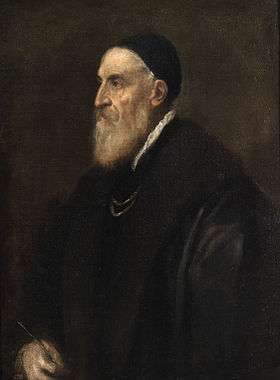Salome (Titian)
 | |
| Artist | Titian |
|---|---|
| Year | c. 1515 |
| Medium | Oil on canvas |
| Dimensions | 90 cm × 72 cm (35 in × 28 in) |
| Location | Doria Pamphilj Gallery, Rome |
Salome is an oil painting by Italian late Renaissance painter Titian, dated to around 1515 and now held at the Doria Pamphilj Gallery in Rome.
History
It has been argued by scholars that Tiziano Vecellio, better known to most as Titian, is the most accomplished and valuable painter of the High Renaissance. He studied under the direction of prominent mentors, "Sebastiano Zuccati (d 1527), and then successively to Gentile Bellini, Giovanni Bellini and finally was associated with Giorgione”, and managed to adapt the stylistic methods of fellow artist’s aesthetics with his own. That is not to say the Titian was merely a commercial artist, who jumped at whoever threw him a commission. If anything, he borrowed from his mentors out of admiration. Titian managed to combine his Venice schooling, under the guidance of Bellini, with his admiration of lofty didactic paintings and frescos common in Florence and Rome. His approach to painting grew away from the intensely ordered and symmetrical works of a generation before him, yet he managed to maintain a dialogue with his predecessors. Though, Titian held this dialogue with a variety of painting styles that he found interesting or noble. The painting examined here, Salome with the Head of John the Baptist is a work completed at a transition in Titians artistic approach.
Titian expert Wethey states that this Salome is the "Herodias" canvas from the Lucretia d'este Estate passed to Cardinal Pietro before becoming part of the Doria Gallery in 1794. Most likely it is an order by Alfonso d'Este.[1]
A Titian Salome that was part of the collections of Prince Salviati, Christine of Sweden and of Prince Odescalchi is owned by real estate magnate Luke Brugnara. That Salome was also attributed to il Pordenone and Giorgione, and finally to Titian in the late 19th century. There are four autograph copies by Titian of Salome: Doria Gallery's, Brugnara's, one in the Norton Simon Pasedena Museum and one in the Benson Collection of London.
Description
The painting is set in a dark room, with, on the right, an arch opening to a blue sky surmounted by a sculpted angel. It depicts Salome holding the head of St. John the Baptist, helped by a young assistant.
The woman, an example of idealized beauty, was portrayed by Titian in numerous other works of the period, including the Woman at the Mirror, Violante, Vanity and Sacred and Profane Love.
Sources
- Valcanover, Francesco (1969). L'opera completa di Tiziano (in Italian). Milan: Rizzoli.
References
- ↑ Filippo Pedrocco: Tizian, Hirmer 2000, p. 106
External links
- Page at the museum website (Italian)
